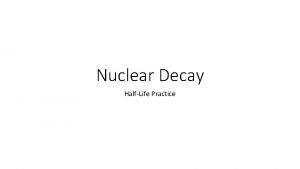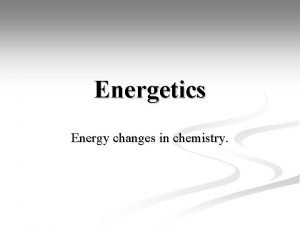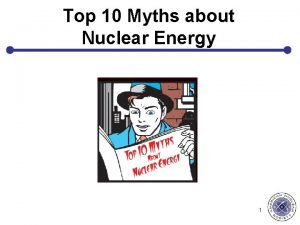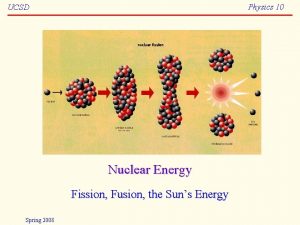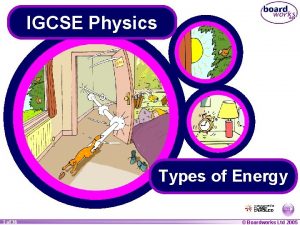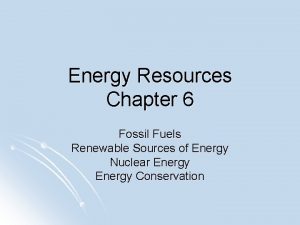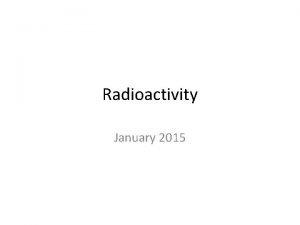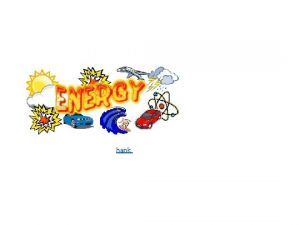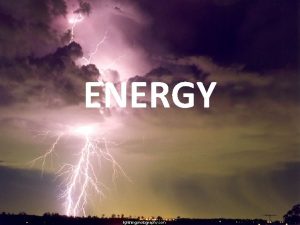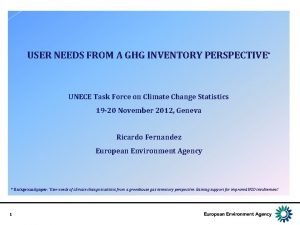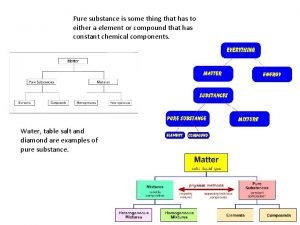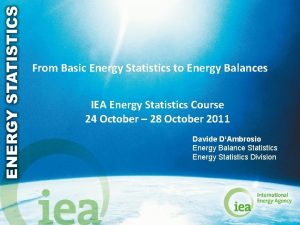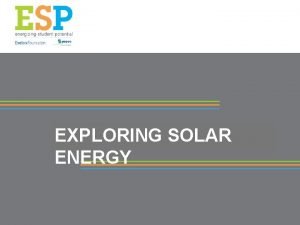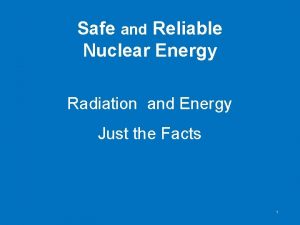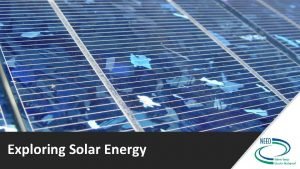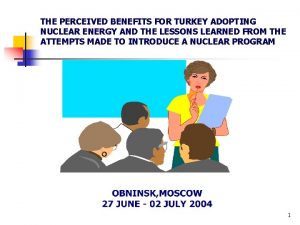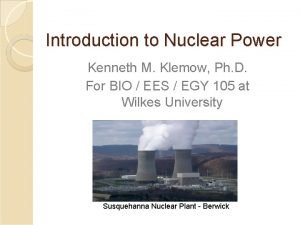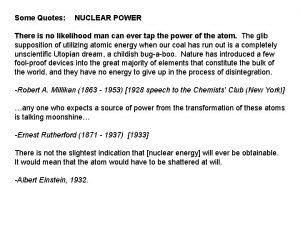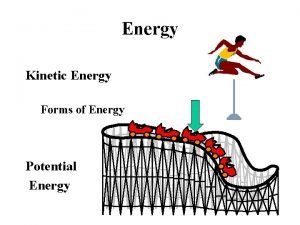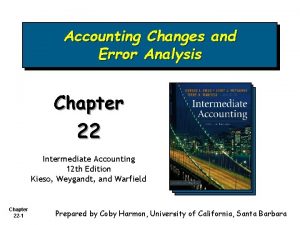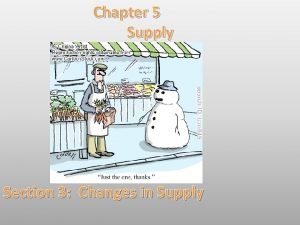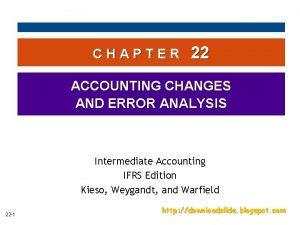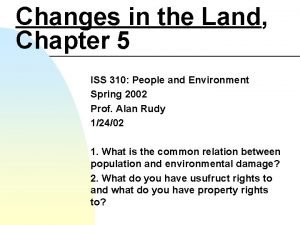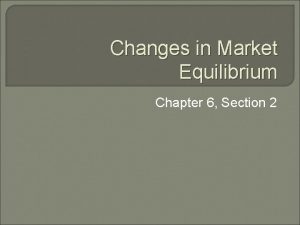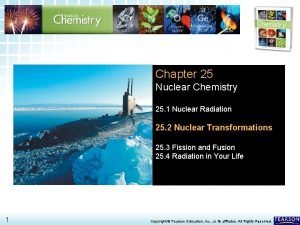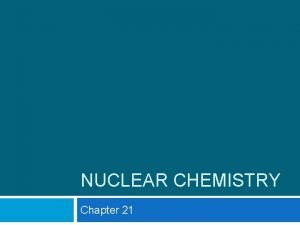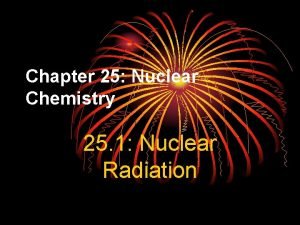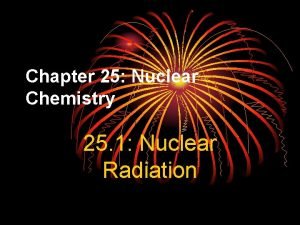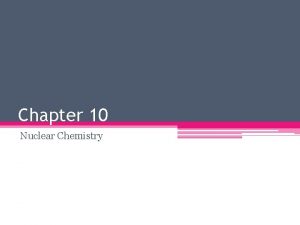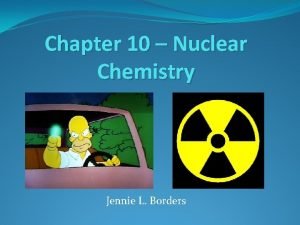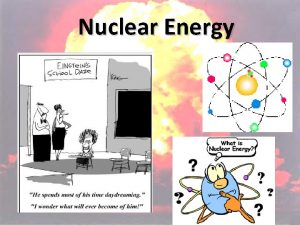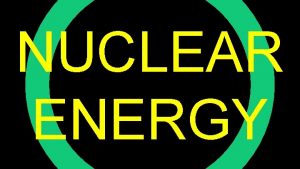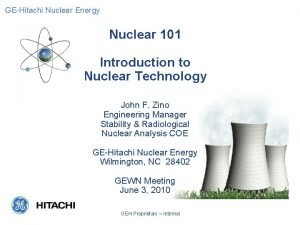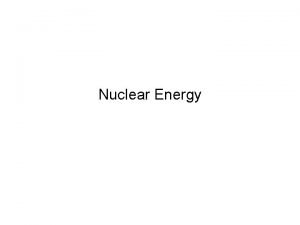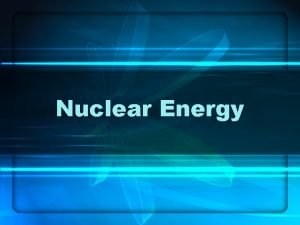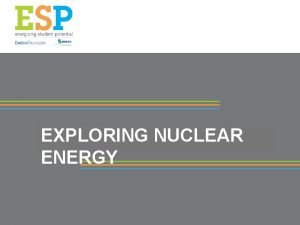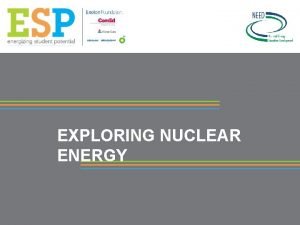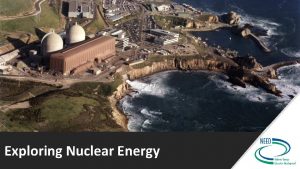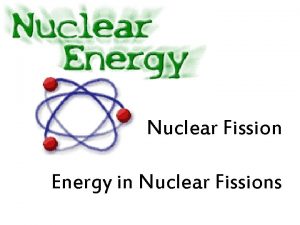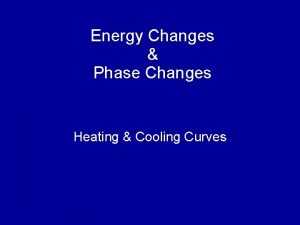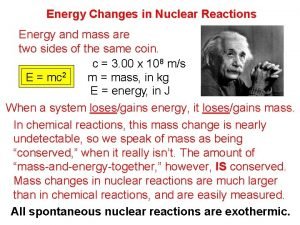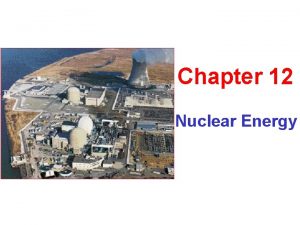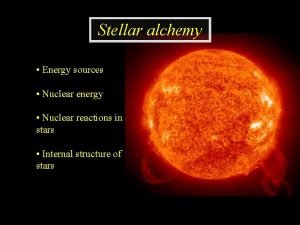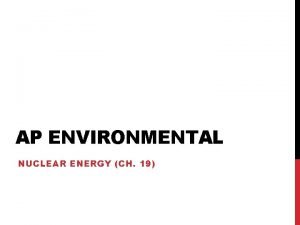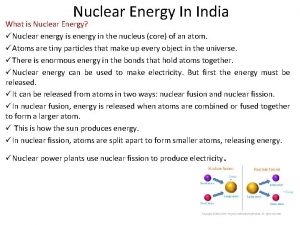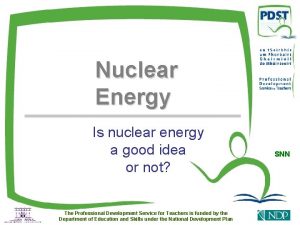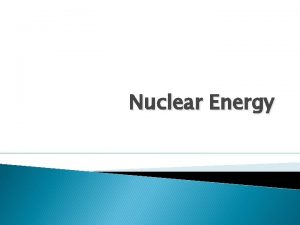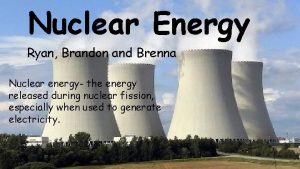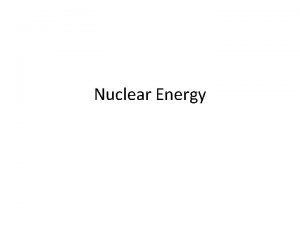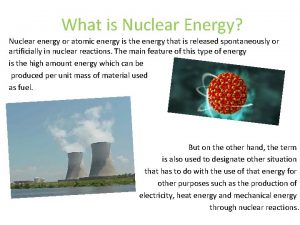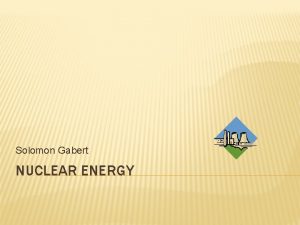Nuclear Changes Nuclear Energy An introduction Chapter 9





















































- Slides: 53

Nuclear Changes Nuclear Energy – An introduction Chapter 9

Radioactivity Radioactive materials have an unstable nucleus that release one or more particles or energy Nuclear radiation refers to the released energy and matter.

v Where does radiation come from? v Radiation is generally produced when particles interact or decay v A large contribution of the radiation on the earth is from the sun (solar) or from radioactive isotopes of the elements (terrestrial) v Radiation is going through you at this very moment!

Isotopes (a review) What’s an isotope? Two or more varieties of an element having the same number of protons but different number of neutrons. Certain isotopes are “unstable” and decay to lighter isotopes or elements. Deuterium and tritium are isotopes of hydrogen. In addition to the 1 proton, they have 1 and 2 additional neutrons in the nucleus respectively*.

Nuclear Radiation As the radioactive nucleus decays, nuclear radiation leaves the nucleus and interacts with other matter. Types of nuclear radiation: (4) 1. Alpha Particles (a) 2. Beta particles (b) 3. Gamma rays (g) 4. Neutron emission v

v 1. Alpha Particles: a positively charged particle and has a large mass. (consists of 2 protons and 2 neutrons). Do not travel far because of its size. v Can barely travel through a piece of paper. v Radium Radon R 226 Rn 222 88 protons 138 neutrons 86 protons 136 neutrons + a (4 He) 2 protons 2 neutrons The alpha-particle (a) is a Helium nucleus. It’s the same as the element Helium, with the electrons stripped off !

v 2. Beta Particles: negatively charged particle that has little mass Travels much faster than alpha particles v Travel through 3 mm of aluminum or 10 mm of wood…but are stopped because they lose energy fairly quickly. v Carbon C 14 6 protons 8 neutrons Nitrogen N 14 7 protons 7 neutrons + eelectron (beta-particle) We see that one of the neutrons from the C 14 nucleus “converted” into a proton, and an electron was ejected. The remaining nucleus contains 7 p and 7 n, which is a nitrogen nucleus.

v Gamma Rays: are not made of matter and do not have an electric charge v Gamma Rays consist of electromagnetic energy called PHOTONS v Have very high energy…can travel through 60 cm of aluminum or 7 cm of lead v Gamma Rays are more dangerous to living things than alpha or beta particles.

Gamma particles (g) In much the same way that electrons in atoms can be in an excited state, so can a nucleus. Neon Ne 20 10 protons 10 neutrons (in excited state) Neon Ne 20 + 10 protons 10 neutrons (lowest energy state) gamma A gamma is a high energy light particle. It is NOT visible by your naked eye because it is not in the visible part of the EM spectrum.

Gamma Rays Neon Ne 20 + The gamma from nuclear decay is in the X-ray/ Gamma ray part of the EM spectrum (very energetic!)

Nuclear Radiation v Neutron Emission: The release of a neutron from a nucleus…does not have any charge. v Can travel much farther because they do not lose energy very quickly. v Can travel through a 15 cm block of lead.

Half-Life ( The “half-life” (h) is the time it takes for half the atoms of a radioactive substance to decay. ( For example, suppose we had 20, 000 atoms of a radioactive substance. If the half-life is 1 hour, how many atoms of that substance would be left after: #atoms % of atoms Time remaining 1 hour (one lifetime) ? 10, 000 (50%) 2 hours (two lifetimes) ? 5, 000 (25%) 3 hours (three lifetimes) ? 2, 500 (12. 5%)

Predicting Age v Scientists use the Half-Life of an object to determine its age. v For example: Potassium-40 decays to Argon-40, so the ratio of Potassium-40 to argon-40 is smaller for older rocks than it is for younger rocks. v Scientists use Carbon-14 to date more recent materials like remains of an animal or parts of ancient clothing.

Practicing Half-Life v Radium 226 has a half-life of 1599 years. How long would it take seven-eighths of a radium-226 sample to decay? v Given: half-life = 1599 years v Given: fraction of sample decayed = 7/8 v Unknown: fraction of sample remaining v Unknown: total time of decay

v 1. Calculate the fraction of radioactive sample remaining. v v Fraction of sample remaining = 1 – 7/8 = 1/8 2. Calculate the number of half-lives Amount of sample remaining after one half-life = ½ v Amount of sample remaining after 2 half-lives = ¼ v Amount of sample remaining after 3 half-lives = 1/8 v 3 Half-lives are needed for one-eighth of the sample to remain undecayed. v v 3. Calculate the total time required for the radioactive decay. v Total time of decay = 3 half-lives x 1599 years = 4797 years

Radioactive Dating Game v Sign out a laptop v Log in and open the Internet v Go to phet. colorado. edu v New Sims - Ph. ET Simulations

Nuclear Energy Basics of Nuclear Power Video Clip

Brief History Nuclear energy was first discovered in 1934 by Enrico Fermi v The first nuclear bombs were built in 1945 as a result of the Manhattan Project v The first plutonium bomb (Trinity) was detonated on July 16, 1945 v The first uranium bomb was detonated over Hiroshima on August 6 th 1945 v The second plutonium bomb was dropped on Nagasaki on August 9 th 1945 v Electricity was produced with nuclear energy in 1951. v

Fission: History and Overview v v v Discovered 1938 by Otto Hahn and Frittz Strassmann Presented in 1939 by Lise Meitner and Otto Frisch Research of Nuclear Fission began U. S. weapons program 1942 first controlled self sustaining fission reaction by Enrico Fermi Nuclear fission creates Electricity

Fission Overview v v Fission is the process of splitting heavier nuclei into lighter nuclei Fission releases Energy The mass equivalent of 1 kg of matter is more than the chemical energy of 22 million tons of TNT Neutrons released by fission can start a chain reaction…a continuous series of nuclear fission reactions.

Fission Today 435 Nuclear Power plants worldwide v 1/6 of the worlds power is nuclear v World Energy Consumption doubled by 2050 v World will turn to fission energy v


World Nuclear Power Plants How Stuff Works - Nuclear Energy

United States Nuclear Power Plants

Nuclear Power in Northeast U. S.

Japan’s Nuclear Power Problems

Japan’s Power Plant Meltdown v Japan’s Nuclear Emergency v Efforts to cool down the nuclear reactor v Concerns about Proximity to the Power plant

Fusion: Overview and History British Physicists in the 1940’s and 50’s housed ina hangar at Harwell a device called ZETA-Zero Energy Toroidal Assembly which was the first fusion based operating system v Masked in the secrecy of the Cold War v Fusion is the production of a thermonuclear reaction in a gas discharge v Called fusion because it is based on fusing light nuclei such as hydrogen isotopes to release energy, similar to that which powers the sun and other stars. v


Fast Facts v. A vast, new source of energy v Fuels are plentiful v Inherently safe since any malfunction results in a rapid shutdown v No atmospheric pollution leading to acid rain or the greenhouse effect v Sunlight is energy released from fusion reactions in the sun.

The Future is Fusion v The sun is our greatest source of energy…the sun uses fusion. v The source of fusion is vastly abundant in our oceans (an isotope of hydrogen in water) v The waste of fusion is helium, and there is no pollution of long term extent v The price of fusion is estimated to be equivalent to that of fossil fuels v Fusion can give us energy for millions of years

Nuclear Waste

Most used Nuclear Waste Sites

Nuclear Waste v Nuclear Waste has been accumulating since the mid-1940’s and is currently in temporary storage at 131 sites in 39 states v Nuclear waste remains highly radioactive for thousands of years. v It will still be potentially harmful to humans long after the manmade containers holding the waste have disintegrated.

Yucca Mountain Will become the nation's first longterm geologic repository for spent nuclear fuel and high-level radioactive waste that is currently stored at 126 sites around the nation. v Yucca Mountain is located in a remote desert on federally protected land within the secure boundaries of the Nevada Test Site in Nye County, Nevada. It is approximately 100 miles northwest of Las Vegas, Nevada. v

Nuclear Radiation Today

Radiation v You are exposed to radiation everyday v Background Radiation – nuclear radiation that arises naturally from cosmic rays and from radioactive isotopes in the soil and air v We are adapted to survive low levels of this natural source of radiation v Radiation is measured in rems or millirems

What are the Possible Effects of Radiation? v Inside Chernobyl - National Geographic Magazine v Kasakhstan Fallout Video Clip v Safety Videos v Duck and Cover v Living Under the Shadow of the Nuclear Umbrella Video Clip

Radiation Exposure v There are many occupations where people are exposed to higher levels of radiation. v Nuclear radiation, health physics, radiology, radiochemistry, X-ray technology, MRI v It has been decided that these occupations can be exposed to 5000 millirems annually plus regular background radiation. v Exposure amounts will also depend on where a person lives. v Exposure may increase based on some day-to-day activities as well

Radiation Exposure v v v v Average annual radiation dose is 360 millirems person. 300 from natural sources. Sleeping next to someone for 8 hours: 2 mrems Exposure comes from the naturally radioactive potassium in the other person's body Coal plant, living within 50 miles: . 03 mrem There is much thorium and uranium in coal. Living within 50 miles of a nuclear power plant adds. 009 mrem of exposure. Both figures are considered extremely low levels. Living in a masonry home: 7 mrems Stone, brick and adobe have natural radioisotopes in them. Living on the Earth: 200 mrems We are living in a sea of radon. It is made from the natural decay of uranium and thorium in the soil, left over from the creation of the solar system. Radon is a rare gas that diffuses out of soil and into the air. It contributes more than half of our background

v v v Smoking: up to 16, 000 mrems The tobacco leaf acts like the absorbing surface of charcoal in a radon test kit. It collects longlived isotopes of airborne radon, like lead-210 and polonium. Small portions of the lungs can get relatively whopping doses, compared to background levels. Porcelain teeth or crowns: tenths of a rem Uranium is often added to these dental products to increase whiteness and florescence. Air Travel: 1 mrem per 1000 miles 30, 000 feet above the ground you're closer to the ionizing radiation (high-energy gammas well as particles) from the sun. Grand Central Station, NYC: 120 mrem for employees Its granite walls have a high uranium content. Brazil Nuts: This is the world's most radioactive food due to high radium concentrations 1000 -times that of average foods. The US Capitol Building in Washington DC: This building is so radioactive, due to the high uranium content in its granite walls, it could never be licensed as a nuclear power reactor site.

Radiation Exposure 1500% increase in incidence of testicular and ovarian cancer in children on Navaho reservation in uranium mining area v 500% increase in bone cancer in children affected by uranium v 250% increase in leukemia (all ages) in the Navaho population v 200% increase in each of the following non-cancer effects: miscarriage, infant death, congenital defects, genetic abnormalities, learning disorders. v

v v 400% increase in leukemia incidence in the population living downwind of the Pilgrim nuclear power reactor in Massachusetts in the first 5 years after fuel was know to have leaked excess radioactivity. Baseline: Disease in population before and after Pilgrim radioactive releases and comparison to upwind population. 300— 400% increase in lung cancer in the general population within the plume of the Three Mile Island accident releases 600— 700% increase in leukemia in the general population within the plume of Three Mile Island accident releases Baseline: Disease in population upwind (out of the radiation plume path) is compared to disease in population downwind (in the pollution plume. ) 50% increase in childhood cancer incidence in the Three Mile Island area for each 10 millirem increase in radiation exposure per year.

500% increase in leukemia among Utah nuclear bomb test Downwinders v 121% increase in thyroid cancer incidence in the same group v 200% increase in breast cancer v 700% increase in bone cancer v a greater then 120% increase in thyroid cancer in those who drank milk laced with Iodine-131 from atmospheric nuclear weapons tests v 200% increase in lung cancer in women who received radiation treatments for breast cancer v 66— 96% increase in early cancer deaths due to background radiation v

Radiation Exposure in the U. S.

Benefits of Nuclear Radiation v Nuclear radiation is used in a controlled way v Smoke Detectors use nuclear radiation in small amounts v Alpha particles are charged and produce an electric current v Detecting disease v Ultrasound, CT scanning, Radioactive tracers

Benefits in Medicine v Radioactive tracers are short-lived isotopes that tend to accumulate in specfic cells…help to find tumors.

Benefits in Medicine v Radiotherapy is used to treat cancers. v Controlled doses of nuclear radiation are used to kill fast growing cells (also damages healthy cells)

Uses in Agriculture v v Radioactive tracers are used to identify the flow of water and how it moves through the crops. Help to identify biochemical processes

NUCLEAR RADIATION: A REVIEW

Risks of Nuclear Radiation v Nuclear radiation reacts with living tissue (alpha, beta, and gamma particles) v They change the number of electrons in atoms of living materials v Alpha particles – stopped by layer of clothing v Beta particles – travel through a fraction of an inch in solids and liquids v Gamma particles – depends on energy … can travel through several feet.

Nuclear Radiation

Risk and Amount of Radiation v Small amount of nuclear radiation --- changes cannot be detected. v Relationship with high levels of nuclear radiation and cancer v Cancers related to radiation levels include: leukemia, breast cancer, lung cancer, and stomach cancer
 Changes in latitudes, changes in attitudes meaning
Changes in latitudes, changes in attitudes meaning What is physical changes
What is physical changes Lithium halflife
Lithium halflife Lesson 15 nuclear quest nuclear reactions
Lesson 15 nuclear quest nuclear reactions Fisión nuclear vs fision nuclear
Fisión nuclear vs fision nuclear Energy energy transfer and general energy analysis
Energy energy transfer and general energy analysis Energy energy transfer and general energy analysis
Energy energy transfer and general energy analysis How to calculate enthalpy change
How to calculate enthalpy change Energy changing form
Energy changing form Energy changes
Energy changes What is thermochemistry
What is thermochemistry What are fuels used for
What are fuels used for Nuclear fission
Nuclear fission Energy igcse physics
Energy igcse physics Nuclear energy vocabulary
Nuclear energy vocabulary Nuclear energy examples
Nuclear energy examples Nuclear energy examples
Nuclear energy examples Nuclear energy examples
Nuclear energy examples What are audible and inaudible sounds
What are audible and inaudible sounds What is the unfccc
What is the unfccc Sound energy
Sound energy Unece nuclear energy
Unece nuclear energy Nrel
Nrel Nuclear energy facts
Nuclear energy facts Nuclear energy facts
Nuclear energy facts Radiant energy
Radiant energy Nuclear energy
Nuclear energy Uses of nuclear energy
Uses of nuclear energy There is no likelihood
There is no likelihood Mechanical energy
Mechanical energy Chapter 7 energy conservation of energy
Chapter 7 energy conservation of energy Equation analysis sheet
Equation analysis sheet Chapter 10:1 myths on aging
Chapter 10:1 myths on aging Chapter 22 accounting changes and error analysis solutions
Chapter 22 accounting changes and error analysis solutions Chapter 5 section 3 changes in supply
Chapter 5 section 3 changes in supply Chapter 3 analyzing changes in financial position answers
Chapter 3 analyzing changes in financial position answers Chapter 21 revolutionary changes in the atlantic world
Chapter 21 revolutionary changes in the atlantic world Chapter 5 section 3 changes in supply
Chapter 5 section 3 changes in supply Chapter 3 analyzing changes in financial position answers
Chapter 3 analyzing changes in financial position answers Counterbalancing example
Counterbalancing example Changes in the land chapter 5 summary
Changes in the land chapter 5 summary Chapter 6 section 2 changes in market equilibrium
Chapter 6 section 2 changes in market equilibrium Chapter 24 nuclear chemistry answer key
Chapter 24 nuclear chemistry answer key Chapter 25 nuclear chemistry answer key
Chapter 25 nuclear chemistry answer key Chapter 21 review nuclear chemistry
Chapter 21 review nuclear chemistry Nuclear fusion
Nuclear fusion Chapter 25 nuclear chemistry
Chapter 25 nuclear chemistry Chapter 10 nuclear chemistry
Chapter 10 nuclear chemistry Chapter 10 nuclear chemistry
Chapter 10 nuclear chemistry Section 2 describing energy (continued)
Section 2 describing energy (continued) Potential energy
Potential energy Primary energy and secondary energy
Primary energy and secondary energy What is commercial energy source
What is commercial energy source Gibbs free energy
Gibbs free energy


